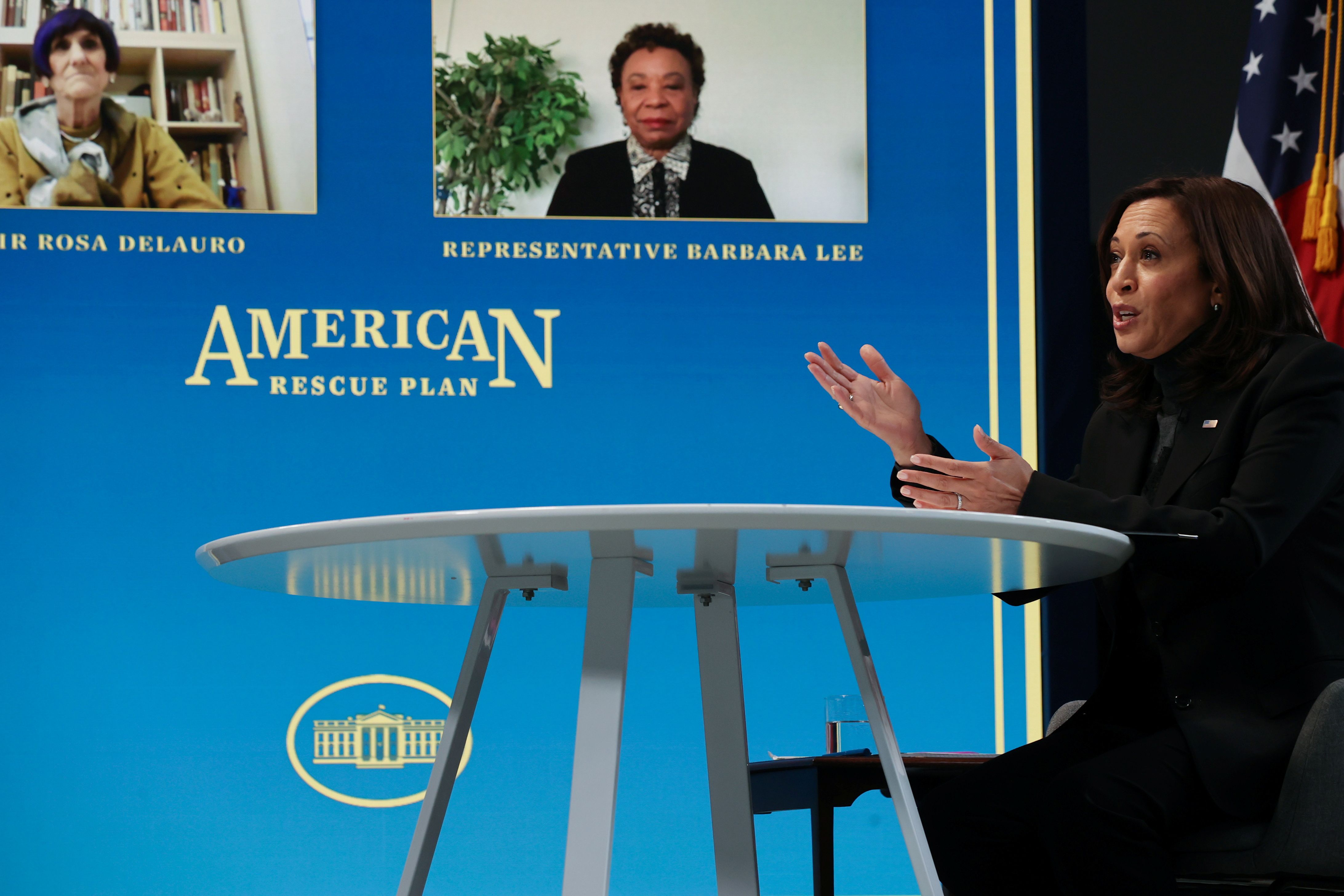Biden's Inflation Reduction Act Seen as Key in U.S. Midterm Elections
On 16 August, U.S. President Joe Biden signed into law the Inflation Reduction Act to complete the Build Back Better economic and political plan that was at the heart of his electoral agenda. The act is intended to contain the soaring costs of living for Americans caused by inflation and to reduce the budget deficit. At the same time, it includes the largest package of measures for climate protection to date, facilitating the implementation of U.S. climate policy goals. The effects of the act will be felt only in a few months, and therefore its significance for the outcome of the November midterm elections to Congress will depend on building an effective campaign message.
 LEAH MILLIS/ Reuters/ FORUM
LEAH MILLIS/ Reuters/ FORUM
Economic and Political Situation in the U.S.
Inflation in the United States has been rising since the beginning of the Biden presidency. In January 2022, it amounted to 7.5% (in January 2021, the rate was 1.4%). After the start of the Russian full-scale invasion of Ukraine, inflation continued to rise (peaking at 9.1% in June and dropping to 8.5% in July). It was driven mainly by the dynamically rising fuel costs—the highest average gasoline price (nationwide) was $5.10 per gallon in June, which was an increase of 50% compared to January this year and 104% to January 2021. The increase in transport costs has driven price increases for a wide range of products, including food. To fight the rising costs of living, the Federal Reserve raised the interest rates four times in one year to 2.5% (the last time it was this high was July 2019).
Inflation has perpetuated the low level of support for President Biden, following the first big drop after the chaotic withdrawal from Afghanistan in August 2021. From January to June this year, it fluctuated in the 40-42% range, then in July it fell to 38%. For comparison, 80 weeks after their swearing-in, support for Donald Trump was 41% and 45% for Barack Obama. Inflation and high fuel prices, as well as the low support for Biden, are the main pre-election problems for Democrats, who are struggling to maintain control over both chambers of Congress in the midterm elections (8 November). According to simulations in June, a Republican majority in the House of Representatives was almost certain (they are counting on an average of 235-238 out of the 435 seats), while in the Senate it is possible (51 out of 100 seats).
The completion of the reform plan originally announced as Build Back Better (BBB) was seen as a chance to improve the economic situation and a legacy project of the Biden administration. During the negotiations, the scope and scale of expenditures were debated both within the Democratic factions and with the Republicans. Biden wanted his flagship project to have bipartisan support, but only the first element, the American Rescue Plan, passed in March 2021. The second pillar of the project, the Infrastructure Act, was adopted in November 2021, in a very limited form, which resulted in a weaking of the administration’s image as unable to fully deliver on its promises despite favourable political conditions. All the more important then was the Inflation Reduction Act, conceived as the conclusion to the BBB plan, although also less ambitious than Biden’s original postulates and last year’s project elaborated inside the party. Ultimately, the act is worth $737 billion. It was adopted by the Senate with the tie-breaking vote of Vice President Kamala Harris (51-50). The House approved it in the following days, and it was signed into law by the president on 16 August.
Goals and Expected Results
The stated purpose of the act is to reduce the budget deficit through increased revenue to the federal budget within 10 years. It includes a 15% minimum corporate tax (generating $222 billion) and a 1% tax on share buybacks ($74 billion), increased tax collection ($124 billion), extension of the excess business losses rule ($52 billion), and revenue from the increased sales of prescription drugs ($265 billion). The latter is to come from the reduction in prices of prescription drugs under the Medicare programme, which should increase their availability. The act also strengthens the healthcare system, including extending the Affordable Care Act (Obamacare) by three years.
The most important part of the act, contrary to the name that suggests reducing inflation, is the climate package. At $369 billion, it is the highest ever U.S. financial package for climate protection-related measures. Those investments concern both the promotion of clean energy sources and the reduction of greenhouse gas emissions and pollution. The package includes tax breaks for the use of clean energy, applicable to both private individuals and enterprises, as well as relief and subsidies for citizens for the purchase of electric vehicles, heat pumps, and solar panels made in the U.S. The implementation of these programmes is intended to bring the U.S. closer to its ambitious climate policy goal of a 50% reduction in greenhouse gas emissions by 2030 (compared to 2005 levels). With the act signed into law, a 40% reduction in emissions is estimated, while before its adoption, a 26% reduction was forecast.
In practice, according to the estimates of the Congressional Budget Office, the act will have a slight impact on lowering inflation in the U.S. Critics also point out that some of the subsidies may not reduce the cost of living but increase corporate profits. For example, in response to the $7,500 in tax relief for the purchase of electric vehicles, Ford and General Motors raised the prices of their electric models by $6,000-$8,000. On the other hand, the costs resulting from corporate taxes may translate into lower earnings for employees. Republicans particularly criticise the increased funding of the Internal Revenue Service, seeing it as an increase in bureaucratisation and government oversight over the lives of citizens. They also indicate that the act does not introduce any solutions that would have a real impact on the fight against inflation, but offers subsidies and relief, the indirect effect of which may be to further fuel it.
Conclusions and Perspectives
The implementation of the revamped BBB programme is Biden’s political achievement, especially in view of the low public support for the president. The adoption of the law, even truncated twice, has brought more benefits than not completing the programme. Passing it next year when the Democrats may have lost at least one chamber of Congress would probably have been impossible. Now, the completion of the BBB serves as a pre-election signal that the Democratic Party, despite the different priorities within its faction, can unite on key issues. The record spending in the climate package in particular aims to convince the youngest Democratic voters to participate in the November elections, as climate protection is one of the most important and urgent challenges for them. The results of adopting the act are already visible in the polls. Support for Biden in August climbed to 44%, the highest in a year. The chances of Democrats maintaining control ever the Senate have also increased (possibly winning 51 seats), although Republicans are still likely to gain a majority in the House (229-230 seats).
The economic effects of the adoption of the law through reduced costs for prescription drugs and healthcare, as well as lower energy costs (resulting from discounts and reimbursements), will only start to be felt in a few months. The act will not affect the level of inflation in the short term either, while the reduction of the deficit, to exceed $300 billion, is spread over 10 years. Therefore, the Inflation Reduction Act may increase the Democrats’ chances in the upcoming elections if they build an effective campaign message presenting the act as an example of promises kept and effective cooperation between the president and Congress. On the other hand, in the context of the elections in 2024, when the effects of the act will start to be felt, it may translate into a better result for the Democratic Party in both the elections to Congress and as Biden seeks re-election or another Democratic candidate competes for the presidency.
The allocation of $369 billion to climate protection activities will also increase the international credibility of the U.S., fulfilling President Biden’s ambitious declarations to reverse Trump’s policy in this regard. It will make it easier for U.S. diplomacy to conclude informal climate partnerships and create coalitions of states with common goals in climate protection. At the same time, if the U.S. is consistently committed to meeting the 50% reduction target by 2030, further government action will be needed to enable its full implementation. The law, however, has some negative consequences for the U.S. relations with its allies. Representatives of the EU and South Korea raised the issue of tax relief for the purchase of electric vehicles as discriminatory against non-U.S. producers and pointed to a possible breach of WTO rules. The issue may become a source of tension in relations with the EU, including with the Trade and Technology Council. This may, in turn, hinder attempts to develop a common transatlantic approach to China, already difficult due to the different interests and perceptions of Chinese political and economic activity by the U.S. and its European partners.




_sm.jpg)